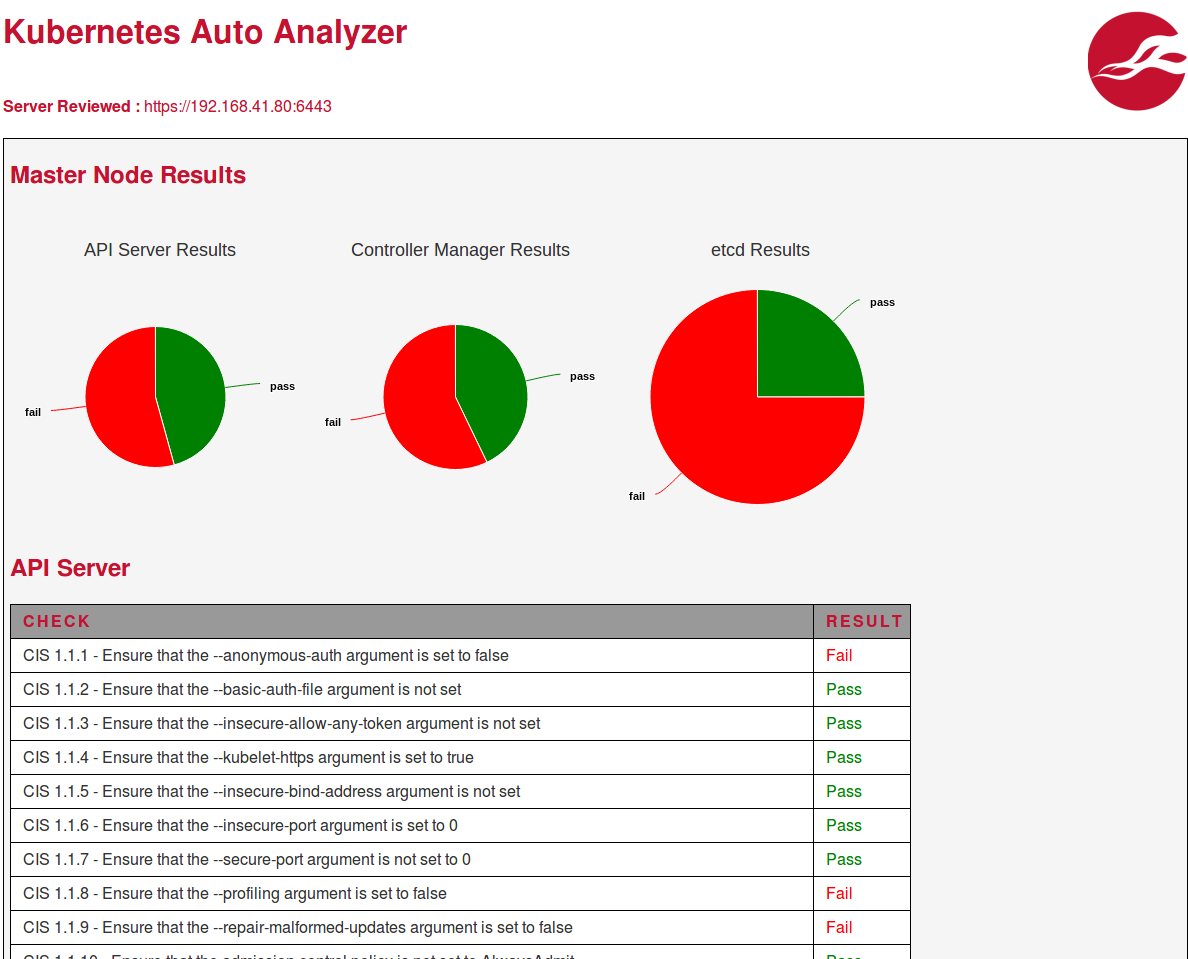This is a configuration analyzer tool intended to automate the process of reviewing Kubernetes installations against the CIS Kubernetes 1.8 Benchmark.
There's two ways to run the analyzer either as a ruby gem or using docker.
To install the ruby gem , just do gem install kube_auto_analyzer and that should put the kubeautoanalyzer command onto your path (assuming you have a sane ruby setup!)
The best way to use the tool is to provide it a KUBECONFIG file to identify and authenticate the session. in that event you can run it with
kubeautoanalyzer -c <kubeconfig_file_name> -r <report_name> --html
If you've got an authorisation token for the system (e.g. with many Kubernetes 1.5 or earlier installs) you can run with
kubeautoanalyzer -s https://<API_SERVER_IP>:<API_SERVER_PORT> -t <TOKEN> -r <report_name> --html
If you've got access to the insecure API port and would like to run against that, you can run with
kubeautoanalyzer -s http://<API_SERVER_IP>:<INSECURE_PORT> -i -r <report_name> --html
Running kubeautoanalyzer without any switched will provide information on the command line switches available.
Unsurprisingly there's an image on Docker hub. To run you'll need to put the config file (if you're using one) in a directory that can be accessed by the docker container and then mount it as a volume to /data in the container e.g.
docker run -v /data:/data raesene/kube_auto_analyzer -c /data/admin.conf -r testdock
The --agentChecks switch will deploy a container onto each node in the cluster to try and complete various checks that need to run from the node. Your cluster need to be able to pull from Docker hub for this to work.
This will also slow things down a bit (depending on your network/cluster speed)
There are two reporting modes available, JSON and HTML. The HTML is intended for humans to read and the JSON for input to other tools. The HTML report should looks something like this.
There's two parts currently implemented by this tool, both wrapped in a ruby gem. The first element takes the approach of extracting the command lines used to start the relevant containers (e.g. API Server, Scheduler etc) from the API and check them against the relevant sections of the standard. This is possible via the API server as the spec. of each container contains the command line executed. At the moment Kubernetes doesn't have any form of API to query it's launch parameters, so this seems like the best approach.
This approach has some limitations but has the advantage of working from anywhere that has access to the API server (so doesn't need deployment on the actual nodes themselves).
In addition to that we've got an agent based approach for checks on the nodes, like file permission and kubelet checks. The agent can get deployed via the Kubernetes API and then complete it's checks and place the results in the pod log which can then be read in by the script and parsed. This is a bit on the hacky side but avoids the necessity for any form of network communications from the agent to the running script, which could well be complex.
One of the challenges with scripting these checks is that there are many different Kubernetes distributions, and each one does things differently, so implementing a generic script that covers them all would be tricky. We're working off kubeadm as a base, but ideally we'll get it working with as many distributions as possible.
- Section 1.1 - API Server - All bar one Checks Implemented (34)
- Section 1.2 - Scheduler - All Checks Implemented (1)
- Section 1.3 - Controller Manager - All Checks Implemented (6)
- Section 1.4 - Configuration Files - Basic Coverage implemented via kaa-agent.
- Section 1.5 - etcd - All bar one Checks Implemented (8)
- Section 1.6 - General Security Primitives - Not implementing directly. These checks are unscored so not really suitable for automated scanning.
- Section 2.1 - API Config - kubelet checks in place via kaa-agent
- Section 2.2 - Configuration Files - Basic coverage implemented via kaa-agent. At the moment we're providing information about file permissions back to the report as there's a lot of variety of locations and file names, it doesn't make a lot of sense to try and actually checking them to provide a pass/fail.
- Section 3.1 - Federation API Server - TBC
- Section 3.2 - Federation Controller Manager - TBC
We're starting to implement checks for common Kubernetes vulnerabilities. Some of these can be derived from the CIS compliance checks, but in order to get more of a chance of picking them up, we're implementing direct checks as well.
- Unauthenticated Kubelet check. Test in place for external access and internal access (via kaa-agent)
- Unauthenticated API access Check. Test in place for external and internal access.
- cluster-admin service token. Test in place for cluster-admin token exposure
- Container Default containment checks. Based on Jessie Frazelle's amicontained We use the agent to check what the default containerization options are for a pod running on the cluster.
- Kubeadm 1.5,1.6,1.7 - Works ok
- kube-aws - Works ok
- kismatic - Works ok
- GCE - Doesn't really work at all. GCE doesn't run the control plane components as pods, so we can't use this approach.
The switch for adding agent based checking is --agentChecks . If you run using this it will take quite a lot longer to complete, as it pulls/runs the container some times.
- Add check on authorization modes explicitly
- Add RBAC roles so we don't just assume cluster admin for running.
- Getting to the point where it would be worth some re-factoring to reduce duplication. specifically abstract common routines like container creation, consistency in variable use etc.
- Updated visuals to do a red/green for the vuln checks

